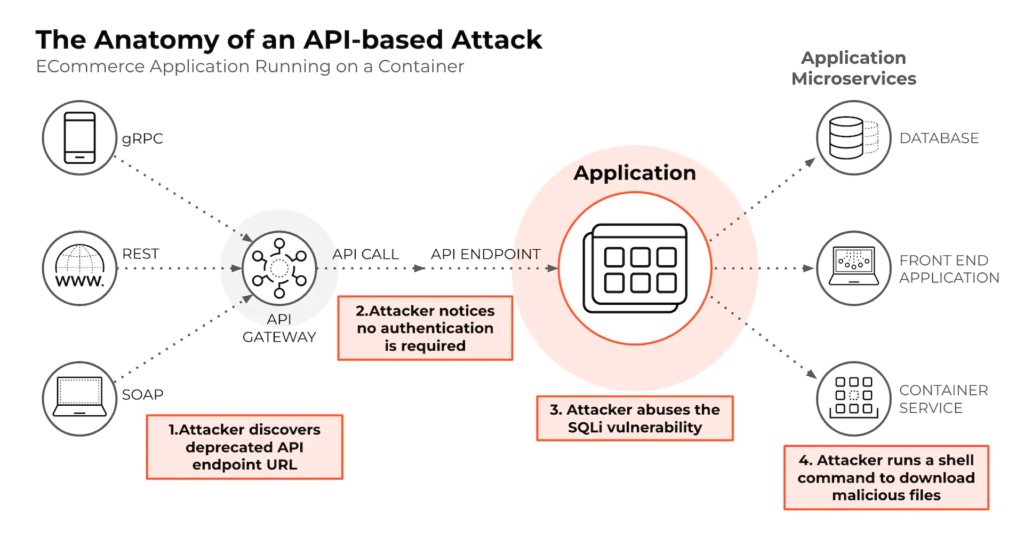Why API Security Is Important
API security is the practice of protecting the application programming interface (API) from attacks that would maliciously use or attempt to exploit an API to steal sensitive data or disrupt services. API security employs strategies, techniques and solutions to ensure that only authorized users can access and use an API and that the data transmitted through the API is protected from unauthorized access or manipulation.
What Is API?
API stands for application programming interface, which consists of a set of definitions and protocols that allows software components to communicate. Serving as an intermediary between software systems, the API enables software applications or services to share data and functionality. But the API does more than provide connectivity infrastructure. It also governs how software applications are permitted to communicate and interact. The API controls the types of requests exchanged between programs, how requests are made, and which data formats are permissible.
Why API Security Is Important
APIs serve as the backend framework for most cloud-native applications, including mobile apps, web applications and SaaS as well as internal, partner-facing and customer-facing applications. To put API use in perspective, Postman, the API management platform, saw 1.13 billion API calls in 2022. With the rise of the API, of course, comes a potentially lucrative attack surface luring bad actors.
Because APIs expose application logic, resources and sensitive data — including personal identifiable information (PII) — they have become a target for attackers. If attackers are able to access unprotected APIs, they can disrupt business, access or destroy sensitive data, and steal property.

Anatomy of an API Attack
As organizations rely on APIs to drive business, attackers are on the prowl for API flaws to exploit. This example of an API attack targeting an e-commerce application with a mobile application as frontend illustrates how easy it is for threat actors to find inroads to valuable data.

Step 1: By reverse engineering the mobile app, an attacker discovers a deprecated API endpoint URL used for retrieving data from a backend microservice.
Step 2: The attacker notices that neither authentication nor authorization are required for sending API calls to this endpoint.
Step 3: The attacker abuses the SQLi vulnerability. The API endpoint URL provides a unique product identifier in the form of a numeric value, and the attacker runs a series of automated checks to discover that the input field <product_id> can be leveraged to carry out a successful SQLi attack.
Step 4: Rather than abusing this SQLi for data tampering, the attacker chooses to abuse the SQLi vulnerability and runs a shell command in the microservice running the SQL database. The shell command downloads a malicious executable and executes it. The executable is a bitcoin mining software.
API Security Best Practices
With APIs increasingly made publicly available, it’s important to address risks of data exposure by implementing best practices to minimize attack surface, remediate vulnerabilities and apprehend malicious activity in near-real time.
Use Secure Authentication and Authorization Methods
Ensure that only authorized users can access the API with secure authentication methods, such as OAuth2 or JSON web tokens (JWTs).
Implement Rate Limiting
Implement rate limiting on your APIs to prevent brute-force attacks and other malicious behaviors. Rate limiting restricts the number of requests that can be made to an API within a specified period.
Use HTTPS
API requests and responses should be made using HTTPS to ensure they’re encrypted and secure. This is particularly critical when dealing with sensitive data.
Perform Regular Security Assessments
Regularly assess the security of your APIs to identify potential vulnerabilities. Review changes to API inventory to detect newly exposed APIs and their risk profiles, including exposure to sensitive data, exposure to the internet, workload vulnerabilities and authentication level.
Use an API Key
An API key is a unique identifier used to identify the application calling an API and verify authorization of access. API keys differ from authentication tokens in that they identify the application (or website) making the API call, rather than the person using the application (or website). Both are important security measures.
Follow API key storage best practices to avoid unwanted calls, unauthorized access and potential data breach with loss of personal information.
Monitor Your APIs
Manage and monitor API specifications, documentation, test cases, traffic and metrics. Block unwanted activity, such as malicious API traffic and bad bots, to help protect the application and reduce unnecessary costs.
Educate Teams About Security Best Practices
Embed security early in the CI/CD pipeline and provide training to improve your developers’ knowledge of security risks, such as weak authentication and logical vulnerabilities. Implement DevSecOps principles, including collaboration between security and development teams.
Know Your Vulnerabilities
Identify weak points in your API lifecycle by routinely looking for OWASP API Security Top 10 risks. Use API scanning tools and techniques to identify each API vulnerability and resolve immediately to prevent exploitation.
Require a Security Token for Authentication
Requiring a security token for authentication is a first line of defense. Security tokens protect APIs from unauthorized access by rejecting the API call if a user’s token fails verification.
Best practices, in short, should start with visibility and monitoring of your attack surfaces, which can auto-discover all the web applications and API endpoints within your environment. Defense layers should include policies for north-south and east-west traffic to block malicious threats, whether they originate from the internet or within your applications.
Adding another layer of vulnerability and compliance scanning, along with strong authentication, will further protect your applications. You’ll also need to secure your workloads or the infrastructure layer, such as the hosts, VMs, containers and serverless functions that help host your applications.
How ActivEdge Technologies Can Help
Modern businesses need to protect their APIs from intensifying threats.
Our modern and cutting-edge solution provides a comprehensive range of capabilities to safeguard, manage, and control access to your APIs, enabling businesses to accelerate their time to market and deliver new apps while maintaining a robust security posture amidst the rapidly expanding API sprawl.
Our solution offers a signed, encrypted gateway and trusted API security policies to provide multiple layers of protection for your data and services. Many of our clients prioritize our solution on their API security checklist because it can effectively quarantine unsecured devices, preventing malicious users from exploiting them. Moreover, it empowers your IT team with various incident response options based on your organization’s security policies, making it a flexible solution that fits a wide range of network architectures and security strategies.
We would be delighted to discuss how our solution can meet your organization’s API security needs. Talk to us today

